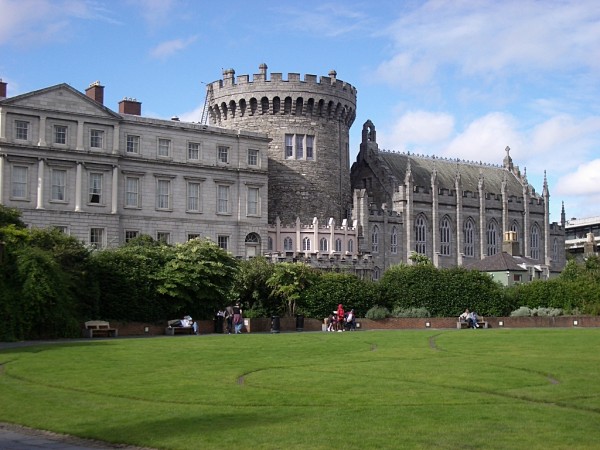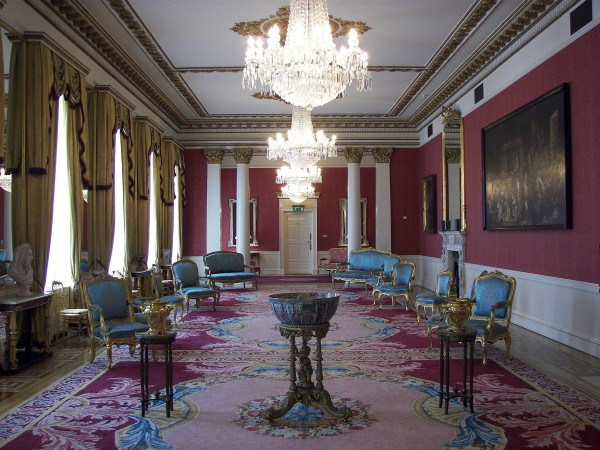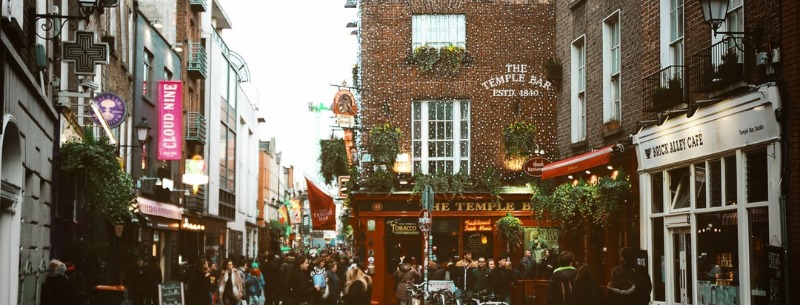Dublin, capital city of Ireland
Dublin is a small capital has a big personality. The perfectly landscaped parks and elegant Georgian architecture will make your head turn, but the biggest draw of the city is the locals themselves. Dubliners are great hosts with infectious and compelling souls. Charismatic and social, the locals will happily lead you to their favorite pubs, tell the colorful history of their heritage and engage in witty banter over a pint of Guinness. Spend time getting to know the city’s people and history, and your trip to Dublin will certainly be memorable.
Dubliners are fiercely proud of their city, and while DUBLIN is the Republic of Ireland’s capital it is quite apart from and can be dismissive of, the rest of the country – one Dublin wag once remarked with characteristic caustic humor that “the only culture outside Dublin is agriculture”. Over the past decade, as young people from rural Ireland and all over Europe, gravitate toward the city to share in the wealth, not experienced since Dublin’s much-celebrated Georgian heyday, this urban/rural divide has started to wane. As a result, Dublin exudes the style and confidence of any cosmopolitan European capital – most apparent at night when Dubliner’s party with a panache verging on the reckless. Dublin’s economic upturn is impacting the city’s rapidly changing urban landscape too, with restaurants, cafés, bars, and clubs opening in abundance, and Dublin’s famous pub scene is now matched by an equally celebrated club scene. On the downside, however, its reputation as one of the party capitals of Europe has attracted droves of “alco-tourists” who arrive in the city for booze-fuelled weekends; they have become such a problem that some areas of the city, such as Temple Bar, have actually banned stag and hen parties.
The spirit of Dublin is undergoing massive upheavals too, with youthful enterprise set against a leaden traditionalism that harks back nostalgically, as in the words of one popular folk song, to “Dublin city in the rare old times”. However, the collision of the old order and the forward-looking younger generations is an essential part of the appeal of this extrovert and dynamic city.
If you approach Dublin by sea, you’ll have an opportunity to appreciate its magnificent physical setting, with the fine sweep of Dublin Bay and the weird, conical silhouettes of the Wicklow Mountains to the south providing an exhilarating backdrop. Central Dublin is not big, and it’s easy to find your way around. One obvious axis is formed by the river, the Liffey, which runs from west to east and acts not only as a physical, but also a social and, at times, psychological dividing line.
The transformation to the top of Europe’s economic class has cast the city economically and culturally into the heart of the continent. This new-found cosmopolitan chic has its home in the vibrant Temple Bar area, “Dublin’s Left Bank”, with its numerous pubs, clubs, galleries, and restaurants. However, for many visitors, the city’s heart lies around the best of what is left of Georgian Dublin – the grand set pieces of Fitzwilliam and Merrion squares, and their graceful red-brick houses with ornate, fan-lighted doors and immaculately kept central gardens, and the wide but strangely decorous open space of St Stephen’s Green. The elegant southside is also the setting for Dublin’s august seat of learning, Trinity College and its famous library where you can see the exquisitely ornate Book of Kells ; Grafton Street, the city’s upmarket shopping area; and most of the city’s museums and art galleries.
North of the Liffey, the main thoroughfare is O’Connell Street, on which stands the General Post Office, the scene of violent fighting in the Easter Rising of 1916. Further north, among Georgian squares older and seedier than the ones you’ll see on the southside, are the Dublin Writers’ Museum and the Hugh Lane Gallery. West again, and you come to Dublin’s biggest open space – indeed, one of the world’s largest city parks – Phoenix Park, home of both the President’s Residence and the zoo.
The urban sprawl quickly gives way to the genteel villages which punctuate the curve of Dublin Bay, from the fishing port of Howth in the north to the southern suburbs of Sandycove with its James Joyce connections, Dalkey, made famous by the comic writer Flann O’Brien, and salubrious Killiney, now colonized by the rich and famous. Added to this is the fact that Dublin must be one of the easiest capitals to escape from, making it a good base for exploring the hills and coastline of Wicklow to the south and the gentler scenery to the north that leads up to the megalithic monuments of the verdant Boyne Valley.
Dublin Castle: the Heart of the City of Dublin
The Dublin Castle was built at the orders of King John of England, back in 1204. The king wanted his new castle to be a fortress, featuring strong walls for the defense of the city, as well as for the protection of his own treasure. In 1673, the building suffered serious damage, due to a fire that almost destroyed it. Actually, soon after this, the castle was demolished, except for the great Record Tower. Reconstruction started in the 17th century and lasted until the 20th century.

Currently, the beautiful castle is used for State receptions and is the host of Presidential Inaugurations. Still, throughout its history, the lovely Dublin castle has served with many other purposes, being a military fortress, but also a prison. The castle was also the place that guarded the King’s treasure. In fact, a very interesting event involving this place dates back to 1907, when the Irish Crown Jewels were stolen from the Castle.

Not only that Dublin Castle is a beautiful and popular attraction in this city, but the castle has been featured in numerous movies. It appeared in movies such as Barry Lyndon, Michael Collins, The Medallion and the famous Becoming Jane. It was even featured in the popular television series The Tudors.
Currently, Dublin Castle is open for visits, so any tourist visiting Dublin can admire the beauty of this castle while learning more about its history. Would you like to visit this beautiful castle in Dublin?
Attractions
Dublin is a small capital has a big personality. The perfectly landscaped parks and elegant Georgian architecture will make your head turn, but the biggest draw of the city is the locals themselves. Dubliners are great hosts with infectious and compelling souls. Charismatic and social, the locals will happily lead you to their favorite pubs, tell the colorful history of their heritage and engage in witty banter over a pint of Guinness. Spend time getting to know the city’s people and history, and your trip to Dublin will certainly be memorable.
The Irish are also proud of their literary history, and there is no better place to explore it than Trinity College. Samuel Beckett, Oscar Wilde and Bram Stoker are among the alumni of the renowned university, which also holds the 1200-year old Book of Kells. The manuscript, handmade by monks, shows the four New Testament gospels in awe-inspiring artistic intricacy.
Continue your literary history tour at the James Joyce Museum, which celebrates the life and work of one of the 20th century’s greatest authors. The first scene of “Ulysses” actually takes place in the tower that holds the museum, and visitors can take a dip in the Forty Foot– the swimming hole featured in the controversial novel.
Literary pub crawls take visitors further into the lives of Joyce and other celebrated scribes who called Dublin home. Tours are packed with history and humor, taking visitors through landmarks dedicated to Joyce, Yeats, Wilde, Beckett, Shaw and others.
The Irish love their music as much as their writers, and the pubs of Dublin often feature foot-stomping sessions with gravelly-voiced locals and fiddles firing off traditional jigs. Nothing else really compares to the cheerful atmosphere of a live session, and some of the best are held at the pubs in the hip Temple Bar area. There, you can expect a decent pint, lively set-dancing and plenty of whistling, yelping and singing. Don’t be afraid to let your guard down and clap along.
While in the Temple Bar area, snag gourmet delights like smoked mackerel, venison sausages and rum breakfast cake. Don’t leave without sampling a thick slice of made-from-scratch soda bread. If you are still craving more Irish cuisine, feast on homemade cabbage soup, creamy blue cheese tarts, to-die-for black pudding and locally made Irish whiskey.
The Irish are famous for their rich legends and myths, and the capital is steeped with them. Dublin castle, an 18th-century fortress, is rumored to be haunted by the spirits of decapitated would-be invaders. The crypt at St. Michan’s Church is filled with the remains of bodies up to 800 years old. Visitors often report hearing voices and whispers throughout the stone church. The ghost of a Newfoundland dog haunts the Glasnevin Cemetery but occasionally creeps around St. Patrick’s Cathedral, startling visitors with its harrowing howl. This is just a small sampling of the souls who apparently never want to leave the city. Visit Dublin for yourself and you will see why!
Dublin Geographical Location
Dublin, translating to “black pool” in English, is located on the eastern shore of Ireland in the vertical center.
It is the most populated city in Ireland with 1,800,000 inhabitants.
Dublin Language
English and Gaelic are the official languages of Ireland although English is predominately spoken in Dublin; Gaelic is spoken more commonly along the western coast.
Dublin Predominant Religion
- 87% Roman Catholic
- 4% Other
- 4% None
- 3% Church of Ireland
- 2% Other Christian
The Republic of Ireland’s constitution specifies that the state cannot endorse any particular religion and guarantees religious freedom.
Dublin Currency
The official currency of Ireland is the Euro.
Dublin Climate
The weather in Dublin is mild all year and usually does not reach any extreme temperatures. It does experience a fair amount of precipitation and during winter months it may snow or hale.
Dublin Main Attractions
- Glasnevin Cemetery (Prospect Cemetery)
- Kilmainham Goal Historical Museum
- National Botanical Gardens
Other Attraction in Dublin
- Chester Beatty Library
- St Michan’s Church
